A Massachusetts Couple Called Off Their Wedding. Who Keeps the $70,000 Ring?

© Caroline Settino, via Reuters

© Caroline Settino, via Reuters

© Petr Josek/Associated Press

© Photo Illustration by Tam Stockton for The New York Times

© Odd Andersen/Agence France-Presse — Getty Images

© Doug Mills/The New York Times

© Doug Mills/The New York Times

© Eric Lee/The New York Times
背景
需求
After yesterday’s accounts of the extraordinary weddings in myth and other narrative, in this article I consider a small selection of depictions of more normal wedding celebrations, from the personal and tender to some amid spectacular scenery.
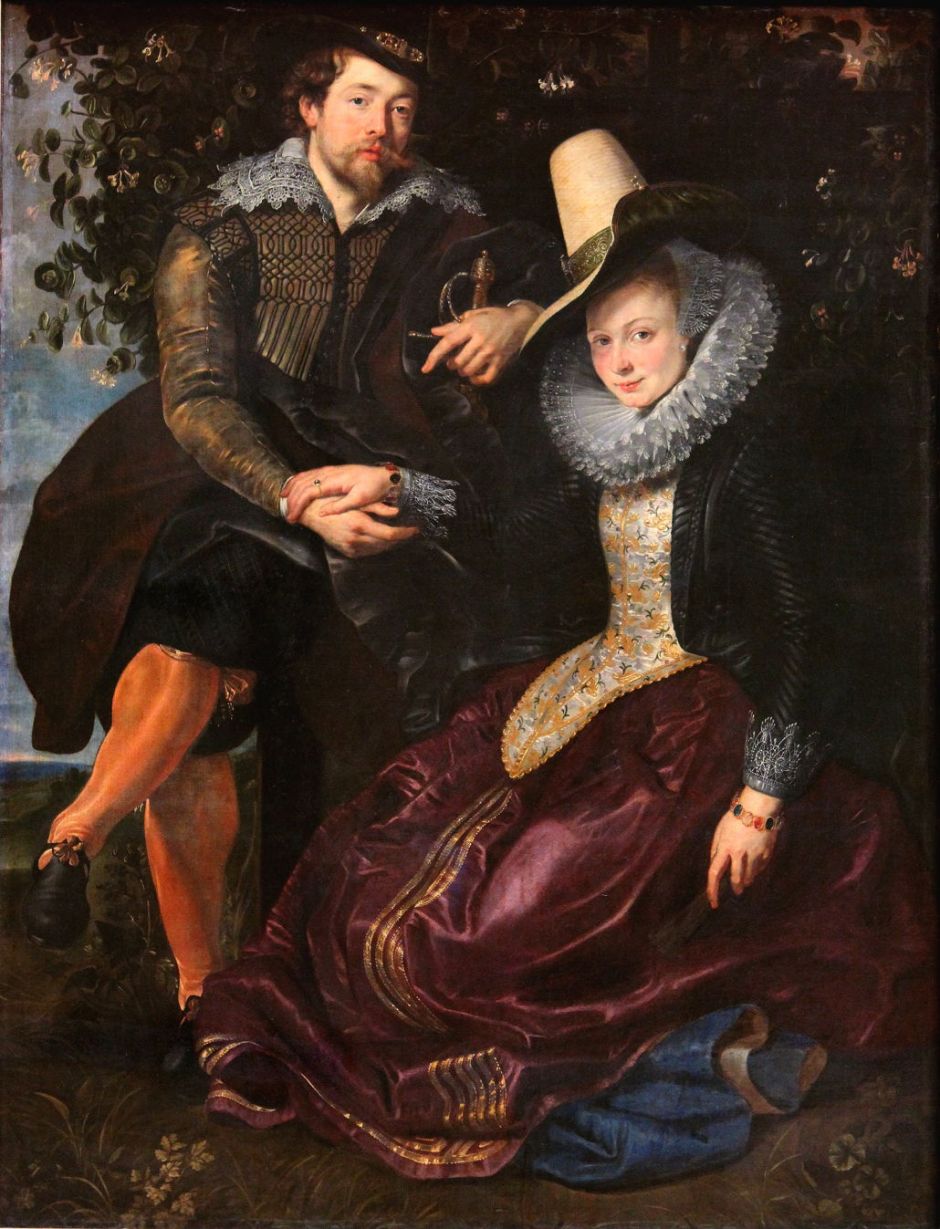
When Peter Paul Rubens married for the first time, to Isabella Brant in the autumn of 1609, he painted this touching celebration, the Honeysuckle Bower, the closest that he could come to the modern wedding photo of bride and groom. Honeysuckle was a well known symbol for faithfulness, and hands laid over one another (“dextrarum iunctio”) have symbolized matrimony since ancient times. Tragically, their bliss was to be short-lived, as Isabella was to die of the plague in 1626 when she was only thirty-four.

Antoine Watteau’s first masterpiece, Marriage Contract and Country Dancing from about 1711, combines three stages of a wedding in a single image, as if in multiplex narrative. In the distance at the far left is the tower of the church where the priest brought the couple together in union in front of God. In the centre, they sign their contract of marriage, while around them is the country dancing of the secular celebration.
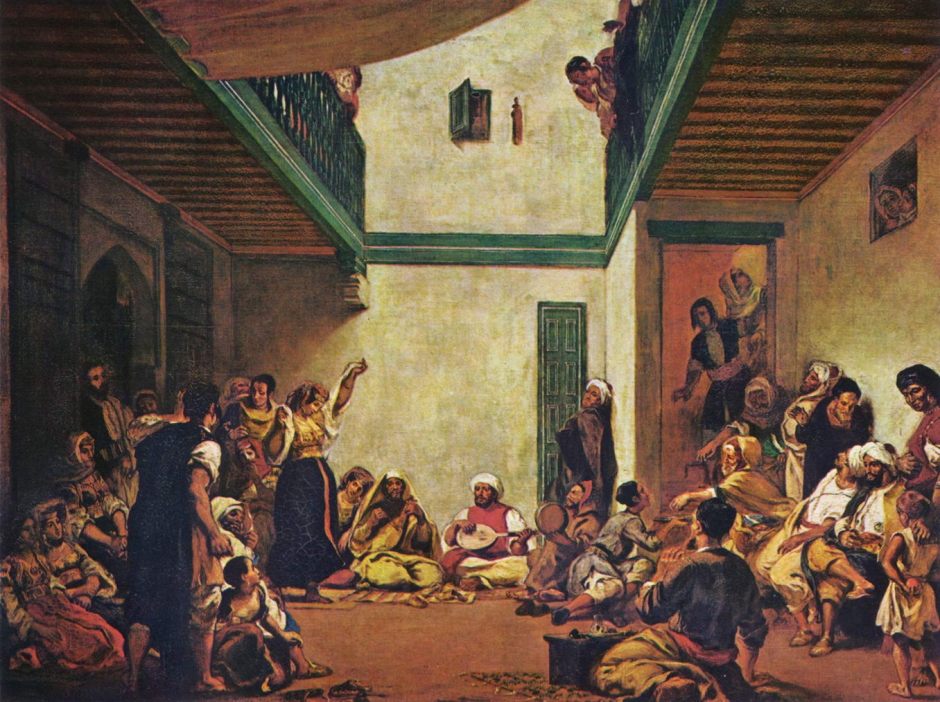
Eugène Delacroix started painting his Jewish Wedding in Morocco in 1837, apparently as a commission, and completed it in time for the 1841 Salon. The viewer is given the opportunity to see one of the women dancing in honour of the bride, in a ceremony clearly intended to be very private.

Weddings in the villages around the fjords of the far south-west of Norway, to the east of Bergen, were very special events. To show this, Hans Gude joined forces with Adolph Tidemand in this marvellous painting of Bridal Journey in Hardanger in 1848. Tidemand’s figures are seamlessly integrated into Gude’s majestic landscape.

Weddings continued through winter in the Carpathian Mountains, in modern Ukraine. Kazimierz Sichulski’s Hutsul Wedding from 1909 shows a wedding party in traditional dress making their way through the snow.
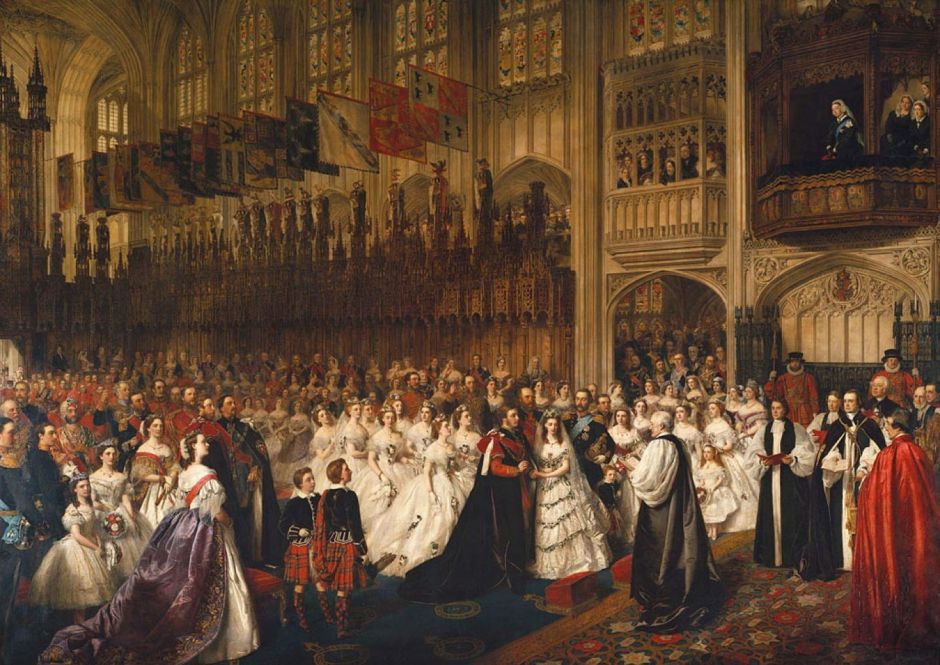
Royal weddings merited pageantry of a different form, as shown in William Frith’s painting of the Marriage of the Prince of Wales, 10 March 1863 completed in 1865. This took place under the watchful eye of the groom’s mother, Queen Victoria (on the balcony at the upper right), who seems to be attracting as much attention as the wedding in progress below her. The groom was to become King Edward VII on the death of the Queen; his bride was Alexandra of Denmark, who was only eighteen at the time. The ceremony took place in Saint George’s Chapel in Windsor Castle. By this time, Victoria’s husband Prince Albert had died and she had effectively withdrawn from public life.

Marià Fortuny, whose interest in ceremony and costume has led to him being dubbed a Costumbrist, painted this intricately detailed view of The Spanish Wedding in 1870. The scene is the interior of a sacristy, where a wedding party is going through the administrative procedures of the ceremony. The groom is bent over a table, signing a document, while the bride behind him (holding a fan) is talking to her mother.
The rest of the wedding party waits patiently, but a woman at the back of the small group turns towards a penitent, who stands to the right of the group. He carries an effigy of the soul burning in flames. The wedding party, and a group seated at the right, are shown in richly-patterned dress, as if attending a masked ball. Their detail contrasts with the more painterly rendering of the surroundings.
In the late nineteenth century weddings changed forever, when they became the preserve of the photographer.
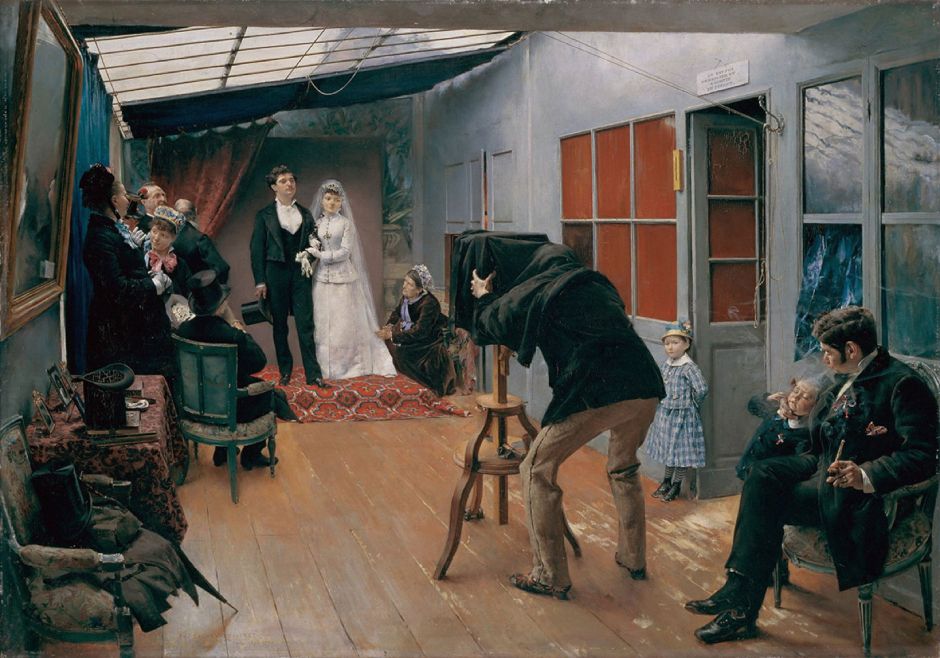
Pascal Dagnan-Bouveret’s A Wedding at the Photographer’s (1879) comes close to a photographic realism throughout the image. He was calculating in his choice of motif: the wedding market wasn’t one that could be catered for by painters, at least not in the way that photographers were starting to capitalise on it. The image gives the appearance of veracity, and uses subtle signs to make photography appear cheap and nasty compared with painting. There is an irony in this painting too, in that Dagnan-Bouveret was one of the first painters to incorporate photography into his working methods, later using it in conjunction with more traditional sketches and studies when preparing major works.
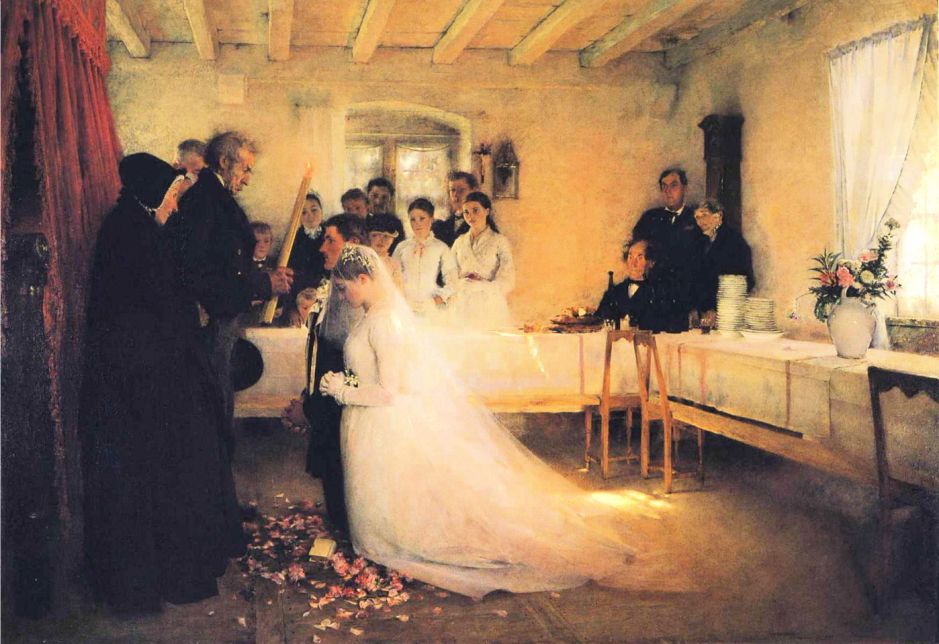
A year or two later, Dagnan-Bouveret revisited the wedding theme without the aid of a photographer, in his Blessing of the Young Couple Before Marriage (1880-81). This traditional subject is lit by brilliant sunshine from the right, which almost makes the bride’s dress appear to be on fire.
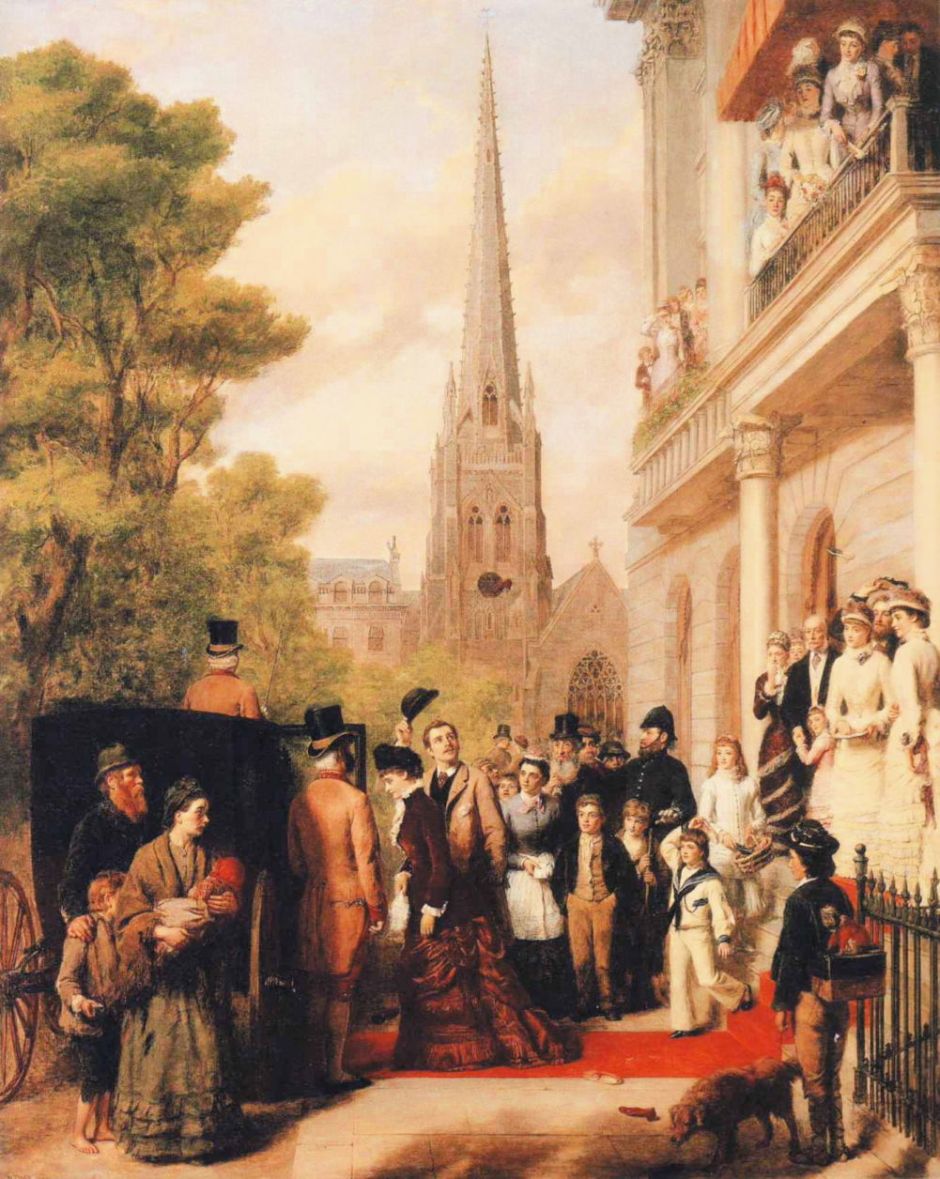
By coincidence, William Frith also returned to the theme at the same time, in For Better, For Worse from 1881. This is one of his Hogarthian paintings, most definitely not by Royal command, and passing comment on contemporary society with its glaring inequalities. He contrasts an affluent couple departing for their honeymoon in a hansom cab, with a poor couple and their two children watching at the lower left, a theme that I’m sure the author Charles Dickens would have appreciated had he not died a decade earlier.
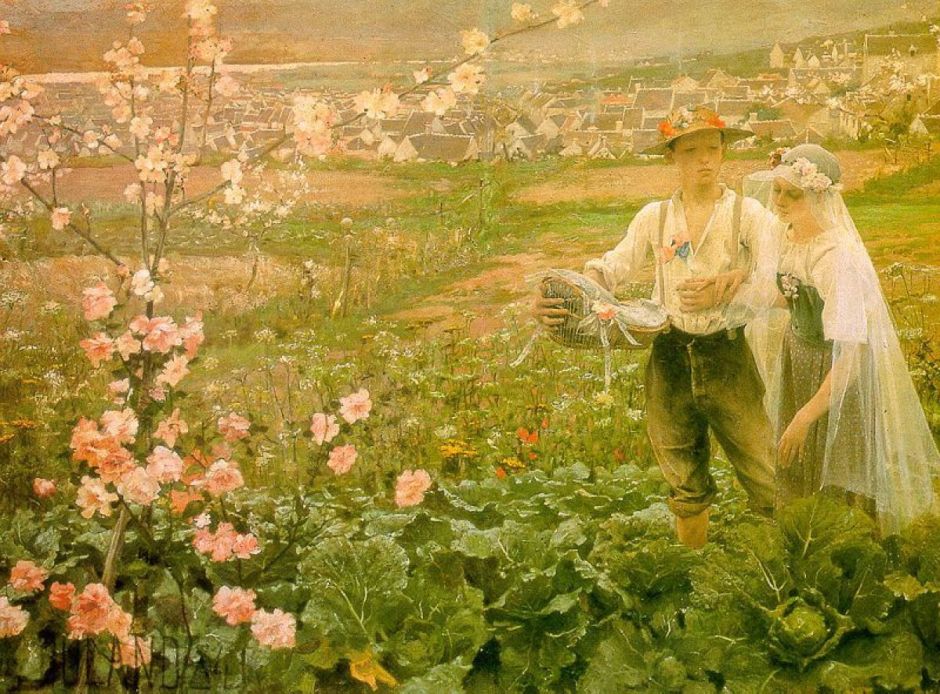
My final nineteenth century wedding painting is by another Naturalist, Jean-Eugène Buland, although here being more than a little sentimental and romantic, even populist. His idyllic Innocent Wedding from 1884 shows a young couple strolling arm in arm through blossom with their home village in the distance.
Since ancient times there have been some who need to live in temporary shelters. If you don’t have a dense wood to hand, then one of the better options is a tent consisting of animal skins or fabric stretched over a frame. If you want to be truly nomadic, then you can pack up your tent and tow it around wherever you want to go. This pair of articles looks at paintings featuring tents; today’s mainly in depictions of stories and events that took place in the more distant past, and tomorrow’s concentrates on their more modern use.
Armies have long been one of the main users of tents, to accommodate their many soldiers in field conditions. For the Greek forces during the war against Troy, that meant a period of ten years. Having lived in a two-man tent in the Antarctic for a period of nine months over the winter, that’s actually not as arduous as it might sound.

Tiepolo shows some of those tents in his fresco in the Villa Valmarana, Vicenza, from 1757. This, the last of them, shows the scene as Eurybates and Talthybius Take Briseis, Achilles’ Concubine, to Agamemnon, who presumably was also living under canvas throughout. As you’ll see in the paintings below, these tents are conical, and likely to be constructed around a central pole or stave.

Francesco de’ Rossi’s fresco of The Inhabitants of Sutrium Supplicate to Camillus to Free them from Tyranny shows a moment in early Roman history, with Camillus and his troops camped outside the town, when the city of Rome was being sacked by Gauls in around 390 BCE. Again, these tents are conical and of similar appearance.

Albrecht Altdorfer’s breathtaking view of the Battle of Issus (1529), fought between Alexander the Great and Darius III of the Achaemenid Empire, in 333 BC, shows a large tented camp in the distance.

Charles Le Brun’s account of The Queens of Persia at the Feet of Alexander, also called The Tent of Darius, is faithful to Plutarch, in placing this event in Darius’ abandoned tent. This appears a more ornate structure, and lacks a central pole, being most probably set on a wooden frame.
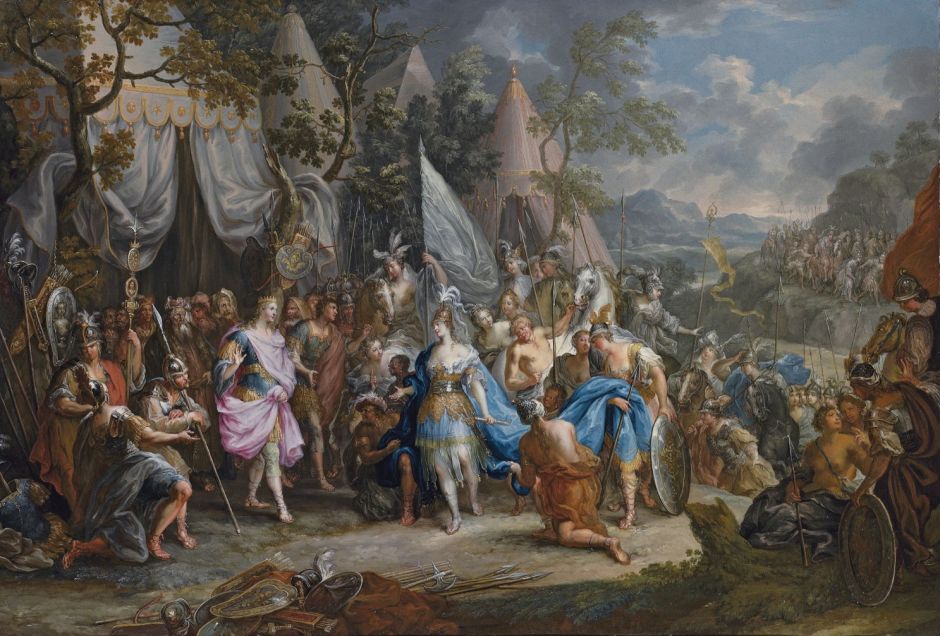
Johann Georg Platzer’s magnificent Rococo The Amazon Queen, Thalestris, in the Camp of Alexander the Great, was painted on copper towards the middle of the eighteenth century. At its centre are the figures of a monarch who could be Thalestris, wearing her crown, waving with her right hand to the arriving Amazons, and showing a fine pair of legs. Next to her is Alexander, who seems to be talking to or about the horse to the right of him (on his left), who could be Bucephalus. Alexander’s tent is great indeed, and pyramidal rather than conical in form, although others look simpler.
The armies that left Europe to fight the Crusades also lived for long periods in tents. Those are shown in paintings of Torquato Tassi’s epic Jerusalem Delivered, a fictional account of the first Crusade of 1096-99.
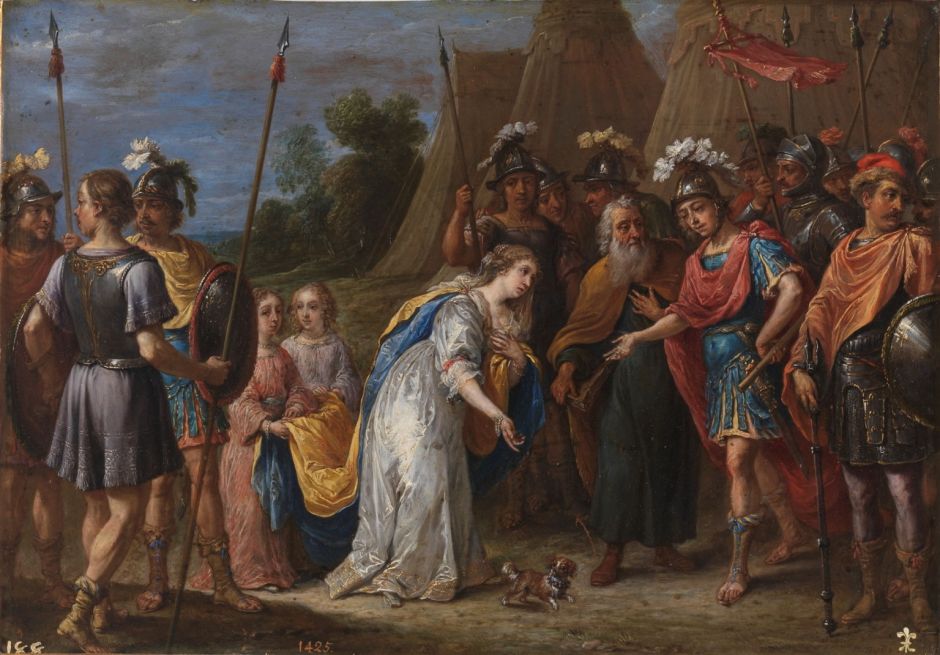
Here, David Teniers the Younger shows Armida before Godfrey of Bouillon (1628-30), amid the tents of the Christian forces, complete with their guy lines, used to tension and brace the structure.

Ary Scheffer’s painting of The Death of Saint Louis from about 1817 is one of a pair commemorating the death of the French King Saint Louis IX (1214-1270). He was a great reformer who got rid of barbarism from justice, including the banning of trials by ordeal. Louis took part in the seventh and eighth Crusades, and died of dysentery during an epidemic that struck the latter. This shows him in a tent on the Libyan coast in the throes of death, surrounded by his court, with the high spears of warriors in the left background.

William Hogarth’s portrait of David Garrick as Richard III from about 1745 shows William Shakespeare’s character waking in his tent with a start following a dream. In the distance are the long rows of conical tents housing his army.

Marià Fortuny’s vast and uncompleted canvas of The Battle of Tetouan (1862-66) shows Spanish forces attacking an Arab camp, to the left, as they advanced towards the city of Tétouan in Morocco in February 1860.

Vasily Vasilyevich Vereshchagin’s After the Attack. Plevna, 1877-1878 (1881) is a brutally frank depiction of the human devastation at a field hospital, with the wounded, dying and dead littered outside its long framed tents.
Although birth hasn’t proved such a popular theme in paintings, there are countless depictions of death. Dominant among them in European works are those of the Crucifixion, but in this brief survey I concentrate on those showing figures from myth, history and contemporary life, particularly those of deathbed scenes, and omit religious paintings entirely.
Adonis is perhaps the only figure whose birth and death have been popular in paintings. Following his strange birth from the myrrh tree, when he was a young adult he bled to death after he had been gored by a wild boar while he was hunting.

Hendrik Goltzius’ startlingly foreshortened projection of the Dying Adonis from 1609 pushes his face and head into the distance and makes their features almost unreadable, while his feet take pride of place and you can even read their soles.
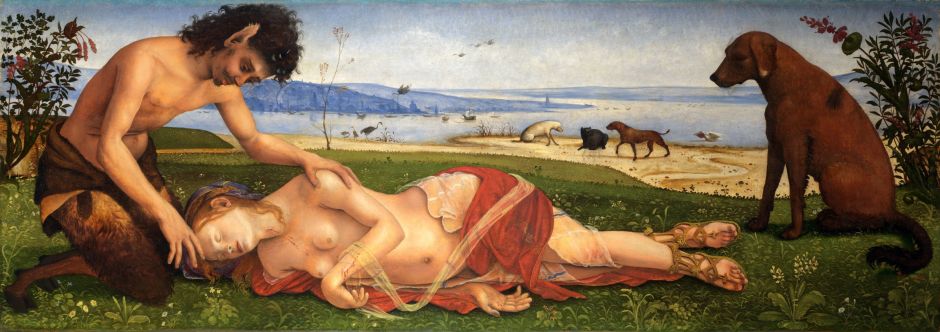
Piero di Cosimo’s wonderful painting of a dying nymph uses the full width of a panoramic panel to show a satyr with his goat legs and distinctive ears, ministering to the nymph, who has a severe wound in her throat. At her feet is a hunting dog, with another three in the distance. Sometimes claimed to show the death of Procris by a javelin thrown by her husband Cephalus, this tells a different and unidentified story.
The death of Dido is more easy to identify, particularly in this depiction by Henry Fuseli, from 1781.
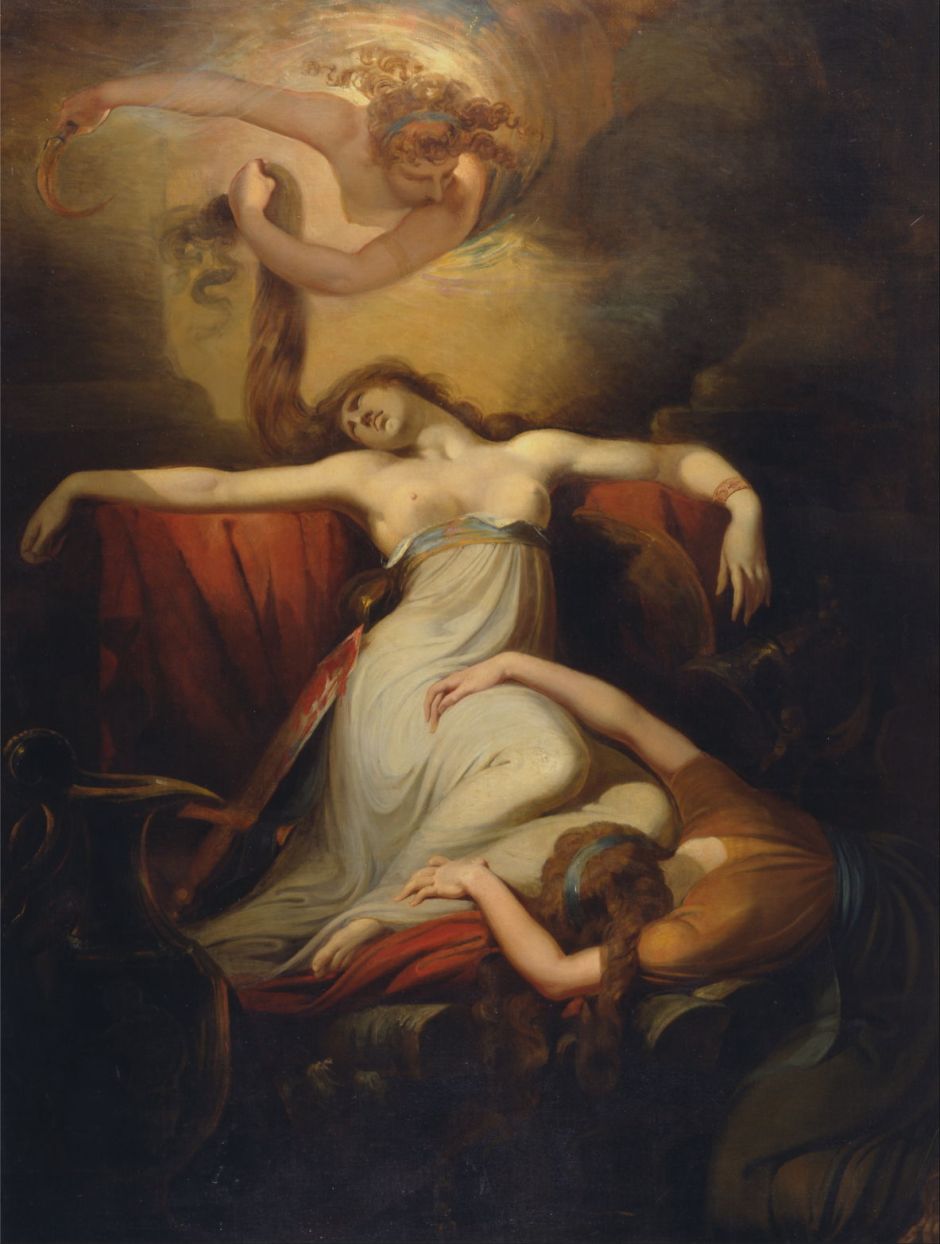
Dido has mounted her funeral pyre, and is on the couch on which she and Aeneas made love. She then fell on the sword which Aeneas had given her, and that rests, covered with her blood, beside her, its tip pointing up towards her right breast. Her sister Anna rushes in to embrace her during her dying moments, and Jupiter sends Iris (wielding a golden sickle) to release Dido’s spirit from her body. Already smoke seems to be rising up from the pyre, confirming to Aeneas that she has killed herself, as he heads towards the horizon, and the eventual founding of Rome.
The story of lovers Pyramus and Thisbe and their tragic deaths has been popular with painters since classical times. When they arrange to meet outside the city, she flees from a lioness, leaving her bloodied cloak. He then arrives and assumes that she has been killed by the lioness and falls on his sword. She returns to find him dying, and falls on his sword so they can be reunited in death. Their spilt blood turns the fruit of the mulberry bush from white to red.

This version from the ruins of Pompeii includes all the main cues, with the lioness in the distance, and a mulberry tree with its white fruit. Its composition has remained in use for the two millennia since then.
More recent legends, particularly those of King Arthur, have formed the basis for some notable painted deathbed scenes.

In James Archer’s The Death of King Arthur from about 1860, the dying Arthur is surrounded by four women, as the black boat approaches the beach behind them. At the right, the ghostly figure of an angel holding a chalice is materialising, in accordance with Sir Thomas Malory’s popular literary account.
Many historical figures have been portrayed in their final moments.

In Paul Delaroche’s Death of Elizabeth I, Queen of England (1828) the haggard queen is shown slumped on a makeshift bed on the floor, putting her low in the painting. Her maids and other female attendants are in distress behind her, supporting the pillows on which her head rests. I presume that the male kneeling by the queen and extending his right hand towards her is Robert Cecil, leader of the government at the time, and behind him are other members of the Privy Council of England, who were shortly to install Elizabeth’s successor.

Benjamin West’s best-known painting of The Death of General Wolfe (1770) shows a scene from an almost uniquely brief battle between British and French forces on 13 September 1759, which lasted only an hour or so. At the end of their three months siege of the French city of Quebec, Canada, British forces under the command of General Wolfe were preparing to take the city by force. The French attacked the British line on a plateau just outside the city.
Within minutes, Wolfe suffered three gunshot wounds, and died quickly. The French commander, General Louis-Joseph, Marquis de Montcalm, was also hit by a musket ball, and died the following morning. The British line held, and the French were forced to evacuate the city, ultimately leading to France ceding most of its possessions in North America to Britain, in the Treaty of Paris of 1763. Wolfe’s death was quickly seen as the ultimate sacrifice of a commander in securing victory, West’s underlying theme here.
Just over twenty years later, it was the turn of the French Revolution to provide a more equivocal hero.

On the morning of 13 July 1793, Charlotte Corday, a young woman from Normandy, turned up at the Paris house of Jean-Paul Marat, one of Revolution’s most influential radicals, asking to see him; his fiancée turned her away. She gained entry later that evening, and started giving him the names of some local counter-revolutionaries. While he was writing them down, she drew a kitchen knife with a 15 cm (6 inch) blade from her clothing, and plunged it into Marat’s chest, killing him rapidly.
David’s famous painting shows Marat’s body slumped over the side of his bath, the murder weapon and his quill both on the floor, the pen still in his right hand, and a handwritten note in his left hand. Corday was executed in public by guillotine on 17 July. Marat became a martyr for the cause, after his friend David had organised one of the spectacular funerals for which he had become known.

When Théodore Géricault, who had painted The Raft of the Medusa in 1818-19, died in Paris on 26 January 1824, the young and promising history painter Ary Scheffer painted his tribute as The Death of Théodore Géricault (1824). At the artist’s bedside are his close friends Colonel Bro de Comères and the painter Pierre-Joseph Dedreux-Dorcy, and the wall of the room is covered by his paintings.

When Claude Monet’s first wife was dying in the late summer of 1879, he painted his tribute to her in Camille Monet on her Deathbed (1879). She appears to be surrounded by diaphanous feathers that rise on either side of her head to form angelic wings. She was only 32, and they had two children.

By the Deathbed (1895) is Edvard Munch’s painting from memory of his sister Sophie resting in her deathbed in 1877, when she was 15 and the artist wasn’t quite 14 years old. She died of tuberculosis, an unfortunately common event at the time. Munch explained that, when painting from memory like this, he depicted only what he could remember, and was careful to avoid trying to add details that he no longer saw. This explains its relative simplicity.
Sophie is seen from her head, looking along her length to her feet, her figure compressed into almost nothing by extreme foreshortening. Her deathbed resembles the next step, in which her body will be laid out in a coffin prior to burial. More than half the painting is filled by the rest of the family, father with his hands clasped in intense prayer. At the right is their mother, who had died of tuberculosis herself nearly nine years earlier.
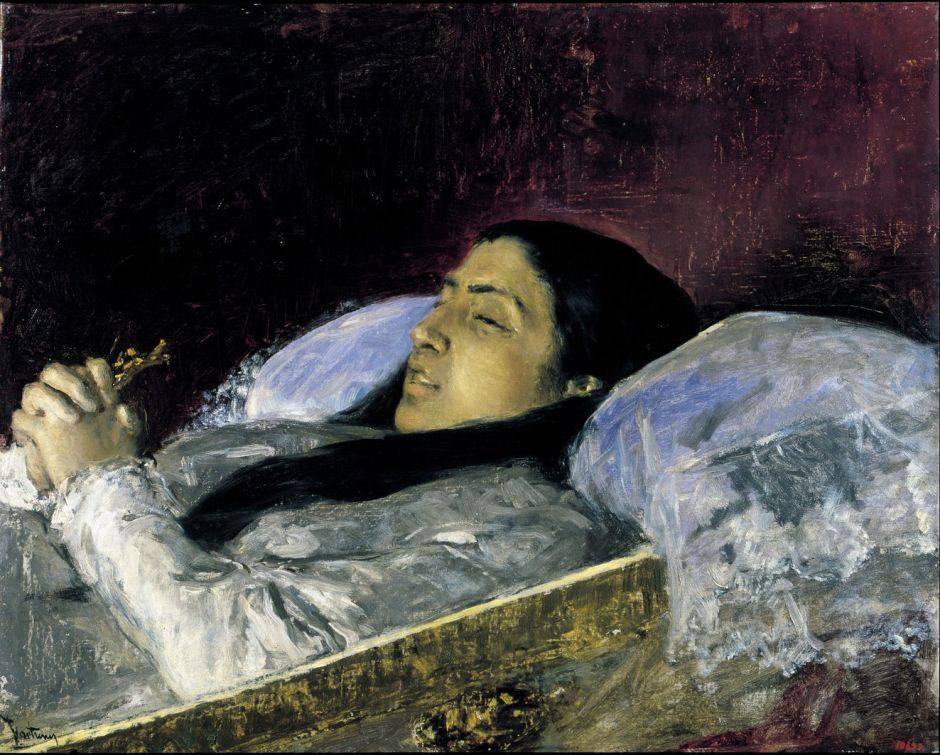
Like Manet and the French Impressionists, Marià Fortuny painted motifs that challenged social attitudes of the day. His portrait of Miss Del Castillo on her Deathbed from 1871 shows a similar scene to Monet’s later painting above.
Sometimes, deathbed and other posthumous portraits prove too great a challenge.

Maria Munk, known as Ria, had been engaged to the actor and writer Hanns Heinz Ewers; when he called off their engagement, she committed suicide just after Christmas in 1911, by shooting herself in the chest. Gustav Klimt was commissioned by Ria’s family to paint a posthumous portrait of her, and first made Ria Munk on her Deathbed, initially completed in 1912 but here dated to 1917-18. She is manifestly dead, and surrounded by floral tributes. The family rejected the work, finding it too distressing, and asked Klimt to depict her when she had still been alive, from photographs.
A second portrait completed in 1916 was also rejected, although there’s doubt about the identity of the painting, and the reason for its rejection. Klimt started his third attempt in 1917, and was still working on it early the following year. It was clearly going to be one of his richly decorated paintings, with abundant colourful flowers in the background, and brilliant peppers and other vegetables. In early January 1918, Klimt caught the deadly influenza that had just started to spread across Europe. He quickly developed pneumonia, suffered a stroke, and died on 6 February 1918.
In the first article of these two considering voyeurism in paintings, I examined classical examples from myth and the popular Biblical stories of King David and Bathsheba, and Susanna and the Elders.
According to legend, King Candaules of Lydia boasted of the beauty of his wife, Nyssia, to the chief of his personal guard, Gyges. To support his boast, the king showed his wife to Gyges by stealth, naked as she was preparing for bed. When she discovered Gyges’ voyeurism, Nyssia gave him the choice of being executed or of murdering the king. Opting for the latter, Gyges stabbed the king to death when he was in bed, then married Nyssia and succeeded Candaules on the throne.

Jean-Léon Gérôme in his early King Candaules from 1859 chose to show the moment that Nyssia removed the last item of her clothing, prior to the moment of peripeteia. The king is in his bed, awaiting his wife, who has just removed the last of her clothing as she spots the dark and hooded figure of Gyges watching her from the open door. Gérôme’s love of detail in the decor saves this from the accusation that this was just another excuse for a full-length nude.
Two years later, Gérôme looked again at this theme.
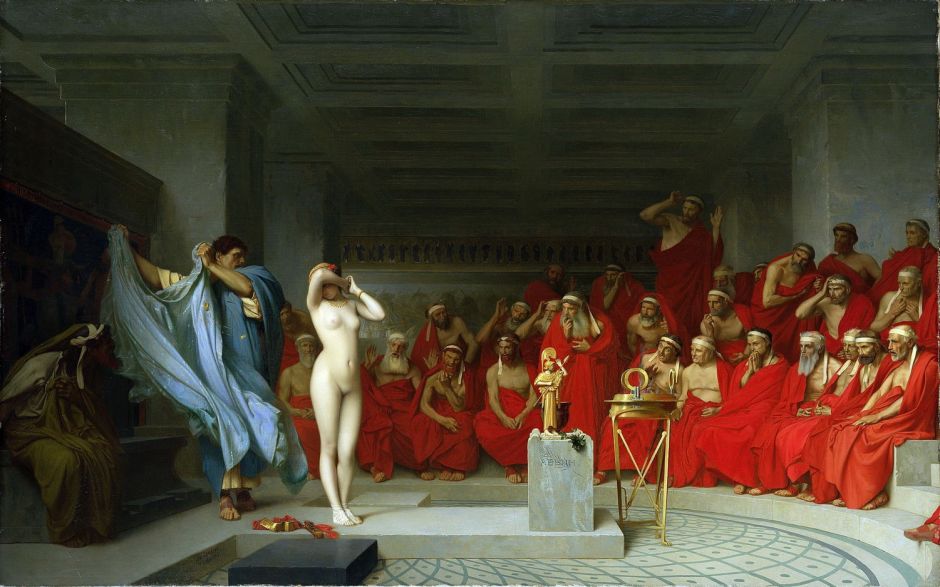
Phryne was a highly successful and rich courtesan (hetaira) in ancient Greece who, according to legend, was brought to trial for the serious crime of impiety. When it seemed inevitable that she would be found guilty, one of her lovers, the orator Hypereides, took on her defence. A key part of that was to unveil her naked in front of the court, in an attempt to surprise its members, impress them with the beauty of her body, and arouse a sense of pity. The legend claims that this ploy worked perfectly.
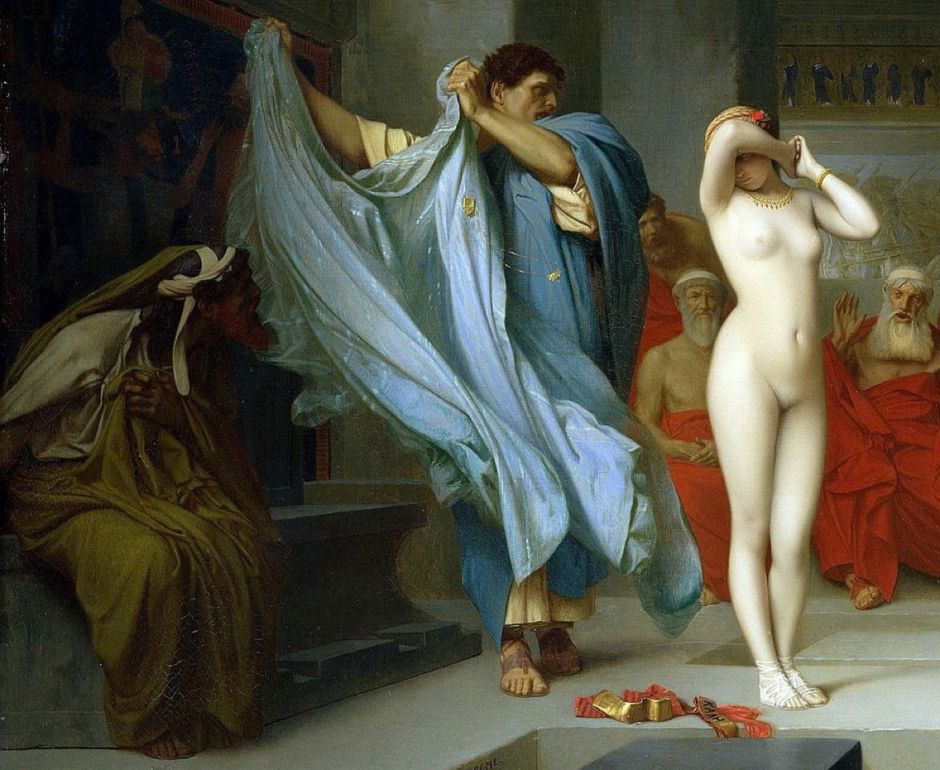
Phryne is to the left of centre, in the midst of the semicircular court, completely naked apart from some jewellery on her neck and wrists, and her sandals. She is turned away from the gaze of the judges, her eyes hidden in the crook of her right elbow, as if in shame and modesty. Behind her (to the left), her defence has just removed her blue robes with a flourish, his hands holding them high. At Phryne’s feet is a gold belt of a kind worn to designate courtesans in France from the thirteenth century, with the Greek word ΚΑΛΗ (kale), meaning beautiful.
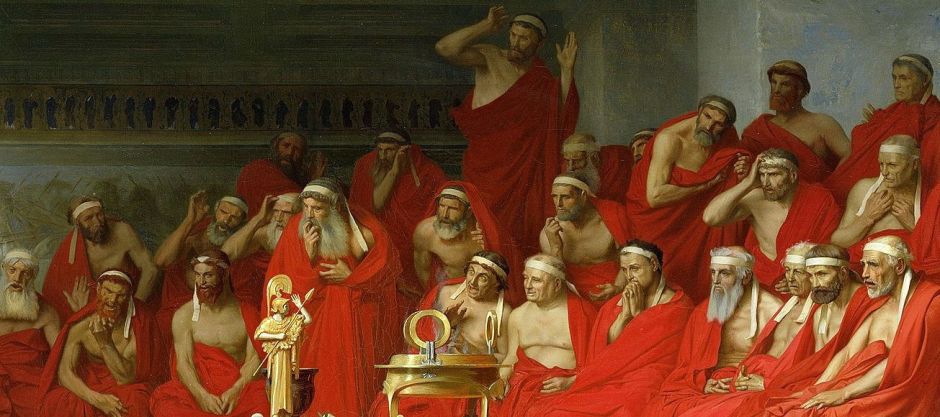
The judges, all men with bare chests and wearing uniform scarlet robes, are taken aback. Gérôme shows a whole textbook of responses from pure fright, to anguish, grief, or disbelief, with each of those men looking straight at Phryne.
Superficially, it’s easy to suggest that Gérôme was using Phryne’s nakedness to appeal to the lowest desires, which remained one of the popular attractions of the annual Salon. However it’s more likely that this is a statement about attitudes to the nude female form, the judgement of the Salon, voyeurism and looking.

In his Musidora And Her Two Companions, Sacharissa And Amoret from 1795, Benjamin West turns to a now-forgotten cycle of poems by James Thomson, The Seasons, published between 1726-30. In this scene from Summer, Damon, who is peeping from behind a tree at the far left, voyeuristically watches the three young women bathing in a stream. He’s in love with Musidora, and towards dusk on a summer’s day is sat in a hazel copse, lost in thought. She, with her two friends, then comes to bathe in the nearby stream, and he watches them undress, forming a “soul-distracting view”. He finally can’t stand the sight any more, writes Musidora a note revealing that he had been watching her, then rushes away. She discovers his note, recognises his writing, and responds with mixed emotions.

Eugène Delacroix’s painting of Louis d’Orléans Showing his Mistress from 1825-26 tells a sordid story of misogyny from French history. Set in about 1400, it shows Louis I, Duke of Orléans, brother of King Charles VI, at the right, displaying the legs and lower body of his mistress, Mariette d’Enghien, to his chamberlain. Her face is obscured because the mistress also happens to be the chamberlain’s wife.

Marià Fortuny pushed the boundaries of what was acceptable in art in his portrait of Carmen Bastián (1871-72). His model here is a young gypsy woman whom he ‘discovered’ in the Barranco de la Zorra, then a desolate area towards Granada’s main cemetery, in Spain. When posing for the painter on his ancient sofa, she provocatively lifted her skirt to taunt him, and make the artist and viewers voyeurs.

Nude on the Beach at Portici (1874) is an excellent example of the balance that Fortuny struck between its vigorously scrubbed-in background, giving a textural feel to the beach, and the virtuoso brushwork he used to render the woman’s body. Its high angle of view and her pose makes this decidedly voyeuristic.
The most prolonged, even exhaustive, period of voyeurism must be in the intimate domestic scenes Pierre Bonnard painted of his longstanding partner Marthe, from 1898 to her death in 1942. Of the thousands of paintings and photographs that he made of her, I have selected just two.

In 1898, Bonnard painted the first of his controversial works revealing his private life with Marthe, in Man and Woman in an Interior (1898), a motif known better from his later version of 1900. He stands naked, looking away, as Marthe is getting dressed on the bed. Its post-coital implications are clear. The image has also been cropped unusually, as if it was a ‘candid’ photo, enhancing its voyeuristic appearance.

Bonnard’s best-known nudes of 1925 are those in which his model is still in the bath, most notably Nude in the Bath. The bath is cropped to show just the lower torso and legs of the woman in its water. A second, clothed, person is striding across from the left, its figure cropped extremely to show just the front of the body and legs.
It is thought that the figure on the left is that of the artist, but I cannot make sense of that. He or she appears to be wearing light patterned clothing consisting of a jacket and long skirt, with soft slippers resembling ballet shoes!
I hope that you’re now feeling thoroughly uncomfortable in looking at all these paintings.

 点击封面播放视频,可以优惠价购买这本书
点击封面播放视频,可以优惠价购买这本书是什么,在炎炎夏日的晚上,让人获得一丝丝清凉与放松的呢?或许,是一段与友人的闲谈,或许是一罐啤酒?可是,你是否想过,为什么,装酒的易拉罐会设计成这样子呢?

 点击播放视频
点击播放视频你可能没有意识到,易拉罐的历史,距今只有短短 61 年。
六十年前,由于消费者需要随身携带开罐器才能打开铝罐,这极大阻碍了初代罐装饮品的推广。自开罐的必要性是显而易见的,但在当时,该领域到处都是失败的原型先例。在一次野餐中,印第安纳州的工具生产商 厄尼 · 弗雷兹 不得不靠着汽车金属杠才打开罐头。经此困扰,他开始着手开发带耳片、可拉开的罐子。他创造了一个跷跷板机制,利用小杠杆,沿着预先半切划线的开口,撬开罐盖。他将小杠杆通过冷焊法固定在罐子的铆钉上,铆钉也使用罐子本身的材料。
他把这个创意,卖给了美国铝业公司。1962年,匹兹堡啤酒公司下了第一笔订单,订购了10万只拉耳罐。许多爱钻研的个人以及公司,继续改进他的发明。1965年,拉耳式开口被拉环取代。1975年,丹尼尔 · 丘德齐克 开发了不必拆卸的拉环装置。打开拉环即可畅饮的易拉罐,撕开了罐装饮料行业的巨大市场,也成为了美国饮品行业的圣杯。

 点击播放视频
点击播放视频方便的工具,总是更受人们的欢迎。尤其是,成瘾性饮料。比起可乐和啤酒,人类更早开始了,对现制咖啡器具的工业化探索。
1933年,意大利人 阿方索·比乐蒂 设计出了摩卡快速咖啡壶。这款炉顶咖啡壶,自1933年首次亮相至今,仍然保持着它的经典设计。
这款壶由3个金属部分组成:用于煮水的底部胆舱,放置咖啡粉的过滤器,以及带有一体式壶嘴的咖啡液收集隔间。煮沸的水穿过咖啡粉,从中间管道顶部如涌泉般流出,一杯富含油脂的咖啡就做好了。
据说,比乐蒂在设计这款咖啡壶的时候,参考了当时的洗衣机。那会儿的洗衣机,由一个锅炉式的底座和顶部的洗涤盆组成。因为铝的导热性能,和多空隙的表面特性,既能快速把水煮开,又能维持住水温,还可以吸收咖啡风味,于是成为了摩卡壶的首选材料。

 点击播放视频
点击播放视频如果说饮料的工业化平权,给人们带去了身体上的享受,那么,随身听播放器则是伴随着流行音乐的黄金年代,给人类带来了空前的精神滋养!
索尼的董事长盛田昭夫认为,人们在任何情况下都需要音乐。这款 1979 年诞生的 TPS-L2,它的外形尺寸仅仅比磁带略大一些,这种便携性,使它超越了不同的市场界限和地域文化影响,大获成功。
德国博朗的设计工作室与日本的极简主义,在索尼身上充分融合。小巧的体型与干净利落的造型,至今仍被津津乐道。
它最初的产品定位是青少年市场,因此在设计上,采用了类似蓝色牛仔布拼接金属色的涂装,并设置了双耳机插孔,以供两人同时靠近彼此。这使得它成为了当时乃至今天许多人心目中,一代经典的流行文化符号。

 点击播放视频
点击播放视频考点众多的设计史,是我读书时期的噩梦。那么多陌生又拗口的人名,我从来都记不住。但是,工作多年以后,我渐渐意识到:
那些经典的设计,都是那个时代下的一次又一次范式革新。
设计史不是设计师史,也不是经典产品史。
当我关注一个设计时,我所关注的是人们如何使用它。人名和产品不是设计史,它们所对应的社会形态、人文环境以及生产技术水平,才是。
设计史是最简便、最低成本的索引目录。
对某个著名设计师的关注,其实远远达不到了解设计。站在宏观的角度去观察,一条已经梳理好的时间轴,就很有帮助。这条时间轴未必符合每个人对历史的认知,但由此发散出来,而关注到的无数分叉,会在日后形成自己的视野有着不可避免的重要性。
任何历史最终都是汇集在一处的。
人类史谈论人类如何进化、如何实用工具、如何创造了古往今来的生活。然而这些生活当中,却也并行着器物进化的历史。这些历史其实是同一部历史,关心设计的历史,就是在关心自己生活在什么样的世界里。
历史是人类的镜子,也是器物的根。
上万年来,人类无数次地重复着同样的错误,然而器物,却一直按照自己的节奏在进化着,从最粗糙的原型里诞生,伴随着人类不断地尝试,衍生出了丰富的世界。
这样的过程,怎么能不迷人呢?
设计史不是人名、地名,不是产品和公司的名字,它是人类和器物之间,相互扶持,纠缠不清的故事,是古往今来的人们,用对生活的热爱,所写下的诗。
在我看来,每一位设计爱好者、在职设计师,我们的案头上都应该至少有一本这样子的书。
做为一本观察世界的魔法目录,它是我们随手可得的一条又一条线索,每一次翻开,都能对我们所处的世界多一份联系和了解。














这次是为 中信出版社 推荐一本新书。这本书由 英国费顿出版社 编著,内容非常丰富。书籍主题专注于探索人类的创造力和想象力,其中包含了许多激发灵感的故事和实用的技巧。无论你是学生、艺术家、工程师还是企业家,这本书都会为你提供独特的思维方式和创造力的启示。通过精心编排的章节,书中详细介绍了各种创造力的来源,从观察自然到探索文化,再到引发思维火花的不同方法。而且,书中还包含了一系列的练习和案例分析,帮助你在实际生活中应用这些创造性思维的技巧。这本书不仅能帮助你在个人生活中拥有更多灵感和创造力,还可以帮助你在工作中更具创新性和竞争力。如果你对提高自己的创造力和想象力感兴趣的话,不妨考虑阅读这本令人兴奋的新书。无论你是专注于艺术、科学、写作还是其他领域,这本书都将成为你的灵感宝库。购买这本书不仅能丰富你的知识,还可以激发你的创造力,并为你的个人和职业发展提供指导和启发。(此段落由 AI 拓展)
 从视频入口下单,会有观众的福利优惠券,电脑端和手机端都有对应的入口。
从视频入口下单,会有观众的福利优惠券,电脑端和手机端都有对应的入口。


视频下方入口可以优惠价购买这本书。
昨天发现 AAAny 更新了发图的功能,于是就顺势发起了一个讨论 AIGC 的话题。
轶轩在话题下问我为什么对外发表的图都是一些细节比较丰富的类型,是否有基于 AIGC 的生成方式而做的一些突破方向的尝试。我觉得,针对这个问题,我可以在对他的回复上,再做一期视频来谈一谈我的观点。






但与此同时,我也想做一些「简练」或「抽象」的图来辅助说明我的看法。于是,今天在工作之余,用一些碎片时间,做了一些图出来。
对此,我尝试比较随意地做了一些「东西」。它们都没有什么明确的「表达」,仅仅只是我随手写的一些 prompt,或者就是在 Midjourney 的社区里复制修改的 prompt,最终出来的东西都是一眼看上去有一些「意境」或者没那么精致细节的但表现比较能唬住人的图像。

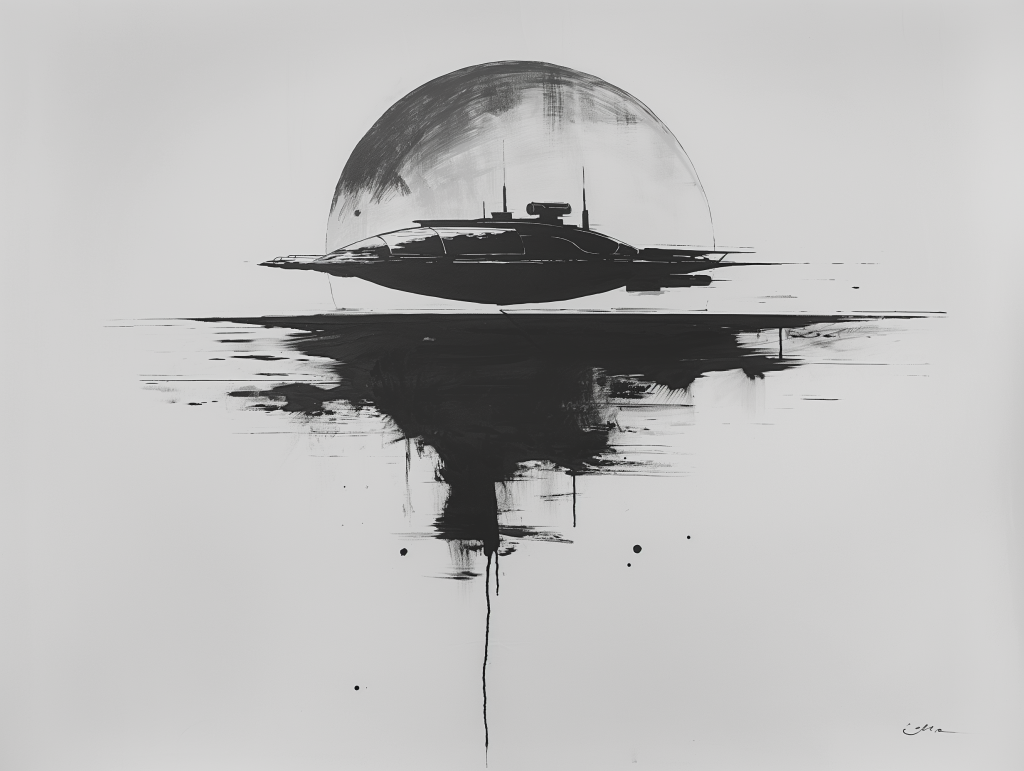

















你会发现,在这些人类认为偏「抽象」的表达上,AI 反而是比较容易做「好」的。
但是,这种好不是真的好,只是这些风格上,并不需要对细节有很认真的考据,在表现层面上是非常容易「糊弄」的。
这也是现当代艺术作品常常被人诟病的原因之一,因为那些作品浓缩了大量的思考和抽象提炼,但表现形式上,其实并没有比传统艺术更复杂,或更需要技艺和体力上的付出。也就是说,作为当代艺术最核心的「观念」,在完全不需要理解的情况下,一个外行的人或者一个数据量管够的 AI 就可以模仿出「看上去像那么回事」的东西。这种模棱两可的状态,恰恰是江湖神棍和 AIGC 擅长处理的对象。
这里说的「糊弄」「神棍」并非贬义,而是借着世俗的话语体系来表达,这样的「生成作品」并不需要 AI 具备「意识」和「创意」也可以轻松地实现。
那么,什么东西是更难的呢?
细节,是令人信服的细节。



这些是我用 AI 生成的男士剃须刀的设计方案。
你会发现,这些方案咋一看是那么回事,但只要你多看两秒,立刻就会意识到它不对。它们的空间关系、形态的处理、物理交互的关系、电子器件的布局,通通都有很大的问题。这些就是不可信的细节。
因为 AI 实际上并不理解它学习的那些图像。
这些令人信服的关键点,是无法糊弄的。因为它们当中包含了大量精确的思考和训练,也包含了海量的脑力和体力劳动,如果一个「智能体」不理解一个图像背后的复杂逻辑,那么它就没有办法真正地创作出这个对象。它只能模仿,只要模仿得足够像,就可以唬住外行。但是对于以此为生的从业者,这样的智能工具,还不足以成为生产力。设计师可以用这样的工具拓展自己的思维,但这些过程并不能替代设计行为。
从创意到落地,中间还有漫长的路需要人类设计师去走完。
现阶段,更适合工业设计使用 AIGC 的方式是这样:





我的意思并不是让 AI 画手绘图,这仅仅是一种表现方式。但是,这是一种不需要追求精确的表达方式,很适合 AI 用「抽卡」的方式来快速堆想法。除了这种,当然也可以让它生成上面剃须刀那样的图,但同样的,目的不在于出方案,而是借助 AI 的海量数据库,快速地堆出一批发散性思维的「胡编乱造」的混杂图像来。
人类的视野有限,但 AI 看得一定比人类个体的平均值多。
工业设计不是天马行空地想象,它是一种「劳作」。
从初期的构思,从草图推延到模型和效果图,再从设计方案导入结构设计和工艺、制程,这意味着工业设计不是一项纯脑力劳动,不是一种只运行在计算机里的行为。它包含的体力劳作同样是设计的一部份,甚至可以说,是更关键的那部份。这种体力劳作,不仅仅是肌肉和工具的配合,更是人脑对环境、事件、社会群体、物质的反应和处理,设计师的动作意味着这个人对世界的认知。这种程度的认知,对于只运行在计算机内,仍然缺少复杂的传感器和理解过程的 AI 而言,暂时还是无法实现的。
我当然相信它未来会具备这样的能力,但是在目前的技术条件下,依然需要大量的人类来完成这些真正代表了「智能」的「体力劳作」。
欢迎加入我们的讨论:
https://aaany.app/aaa/ltwu3txza
想注册体验 AAAny 的话,请给我留言
我会给你留言的邮箱发送注册邀请码

Some forthcoming talks are helping me think through a new book, which I want to start writing in 2023 once Sparks: China’s Underground Historians and their Battle for the Future is out in September 2023 (more on that in a post coming soon).
One of the talks is at the Asia Society on March 1 and has to do with concepts of hell and the afterlife in China–especially how this played out after the Communist Party tried to destroy most values. Details here.
The second, and more relevant talk to my new book is on the idea of Civil Religion in China. I took a stab at this in early 2023 at a talk at Fordham University and will do so in a more systematic way in March at the Wissenschaftskolleg zu Berlin, aka Germany’s Institute for Advanced Studies.
I’ll be on a podium with Franciscus Verellen, a distinguished historian of religious life in middle-period China (and along with Kristofer Schipper the editor of one of the great recent works of sinological study, The Taoist Canon, which is a magically written and illustrated two-volume companion to the canon, which is essentially an encyclopedia of Taoist thought).
Prof. Verellen will talk about state and religion in classical China and I’ll talk about the concept in the country today, especially as the Communist Party uses it to cement legitimacy.
You can see details of both talks on this site’s “Talks and Media Appearances” page. The German talk will be in German. Both will be posted to YouTube, and I think the German talk will have subtitles.
If you get a chance to hear these and have feedback, please do send me an email at ij@ian-johnson.com I’d appreciate any feedback.
Thanks!
The post Hell, Politics, and Religion appeared first on Ian Johnson.
前两天,我收到 AAAny 的 Wenbo 发来的邮件,问我是否有兴趣注册他们的 APP 体验。我一看就乐了,立马截图发给汉洋和轶轩,开玩笑地问道:「我是不是应该告诉他,我早就注册了?」

这个叫做 AAAny 的新问答社区是汉洋他们团队,从 redit 等社区平台的使用中,萌生的对于「Ask Anyone Anything」的重新思考,所做出的产品。我其实几个月前,就在一次和他俩吃饭之后就注册好了。但是一直因为忙,我担心不能及时回复别人的提问,就一直没好意思发起一场主题活动。中途有看到可达和 JT 发起的问答,很感兴趣,也想试试看,但也因为对时间的担心就止住了念头。正好借着这次 Wenbo 的邮件,跟汉洋他俩聊了一会儿后,我就趁着夜色正浓,冲动还在,就立马编辑了两段自我介绍,发起了分别以「工业设计师」和「设计类视频创作者」为主题的两场活动。
点击进入「工业设计师 SUiTHiNK AmA~」
点击进入「设计类视频博主 苏志斌 AmA!」
当天也是高效,一连开了三个会。中途用各种碎片时间,一一回答了 AAAny 上的提问。晚上赶回家陪筱烨过生日的路上,我一看已经回复过的内容,好家伙,累计的输出量都赶上我平时写两三篇文章了。
碎片化地高密度输出,也是可以产生一些好内容的。




在使用了一天后,当晚,我和汉洋、轶轩聊了聊感受。汉洋问我感觉 AAAny 和知乎之间有什么区别?我打了一个比方:
知乎的问答是一种广场上的广播。一个问题对应一个完整的回答,虽然我可以不断修改回答,但是你修改后的内容很难再被之前看过的人再次看到。评论区就是一些人在外围窃窃私语,它们和主回答之间很难形成交流互动。它是有层级的、单向的信息传播。
但是 AAAny 给我的感觉,是老城区的街头沙龙。任何对话都是水平方向的,没有任何层级关系,就和大家在街头聊天一样。你看到一个感兴趣的话题,就可以直接加入;别人对你们正在谈论的感兴趣,也可以随时参与进来。它不是广播的形式,是集会和交流的空间。




有意思的事情在于,我们往往需要遇到好问题,才能写出一个好的回答。
然而,好的问题通常并不是我们提出来的第一个问题。你会在持续的提问和持续的回复之间渐渐发现,那些更本质和更有趣的问题。这是知乎解决不了的。好的问题如果都由运营和编辑来提出,那么知乎的运营压力会爆炸;如果都由用户提出,那么一定伴随着海量毫无意义的垃圾问题,这对真正的好问题是一种掩盖。




因此,持续的对话和前后文关系的保留,就很重要。同时也得确保,来自对话后段出现的好问题/好回答,能够被之前关心这个话题的人看到,也能被后来的观众发现。
运营这样的社区,需要真正会采访的记者。
点击进入「工业设计师 SUiTHiNK AmA~」
点击进入「设计类视频博主 苏志斌 AmA!」